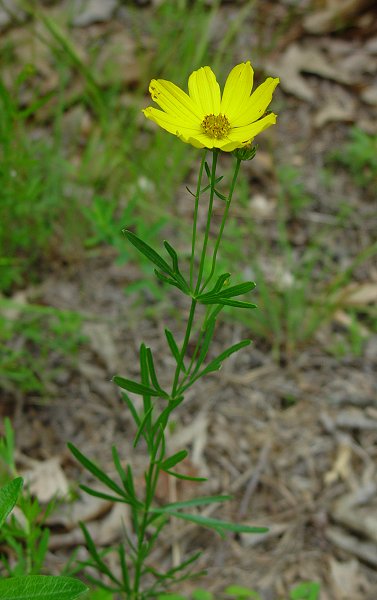Coreopsis palmata Nutt.
Finger Coreopsis

Native
CC = 7
CW = 5
MOC = 63
© DETenaglia
Coreopsis palmata Nutt.Finger Coreopsis | |
 |
Native CC = 7 CW = 5 MOC = 63 |
© DETenaglia |
|
Family - Asteraceae/Heliantheae Habit - Perennial forb, with sometimes long-creeping rhizomes. Stems - Ascending to erect, to 90 cm, single or multiple from the base, simple to branching, green with light green vertical striations, somewhat angled in the upper 1/2, mostly glabrous or with a few spreading hairs at the nodes.
Leaves - Opposite, sessile or nearly so, decussate, distributed at 6-12 nodes along most of the stem length. Blades 3-8 cm long, obovate, deeply 3-5-lobed from well above the leaf base, the lobes sometimes lobed again, the 3-7 ultimate segments 2-7 mm wide, narrowly oblong, sometimes very slightly narrowed toward the base, the surfaces glabrous, deep green. Central lobe typically longer than the lateral lobes.
Inflorescence - Usually solitary terminal heads, the stalk mostly 1-5 cm long. Some flowers axillary from the upper leaf axils.
Heads - Radiate, showy. Involucre cup-shaped, the bracts dimorphic, the outer series 3-8 mm long, green; the inner series 6-10 mm long, yellowish. Chaffy bracts more or less linear, with a slender base, often slightly thickened toward the bluntly to sharply pointed tip. Receptacle flat.
Florets - Ray flowers sterile, 8-10 per flower head, the corolla 15-30 mm long, 2-3 cm long, entire or with 2-4 minute teeth in the center of the otherwise more or less rounded tip, uniformly yellow to orange-yellow. Disk florets perfect. Corollas 5.0-6.5 mm long, 5-lobed, yellow, sometimes with yellowish orange lobes. Style branches tapered abruptly to a sharply pointed, sterile tip. Pappus absent or of 1 or 2 teeth to 0.2 mm long. Stamens 5. Filaments yellow, glabrous, 2 mm long. Anthers brown-purple, 2.0-2.2 mm long, partially exserted, fused around the style.
Fruits - Achenes 4.5-6.5 mm long, the base and tip appearing slightly arched inward at maturity, the angles unwinged or more commonly with narrow, pale wings having entire margins, the inner face not thickened at the ends, dark brown to black, the surfaces smooth. Flowering - May - September. Habitat - Prairies, glades, ledges, bluffs, forest openings, fields, roadsides. Origin - Native to the U.S. Lookalikes - Other species of Coreopsis; more broadly, some species of Bidens, Helianthus, etc. Other info. - This attractive species is found across Missouri, though is apparently uncommon in the northern reaches of the state. It U.S. distribution comprises a tight midwestern band ranging from southern Minnesota to northern Louisiana, and from eastern Nebraska through parts of Indiana. The plant is easily recognized by its showy, all-yellow flowering heads and leaves with a unique shape reminiscent of a turkey foot. It is a common roadside plant in the Ozarks in early summer. It would make a nice garden subject and is deserving of more widespread cultivation. Photographs taken off Hwy 106, Shannon County, MO., 6-6-03 (DETenaglia); also at Shaw Nature Reserve, Franklin County, MO, 5-29-2007 and 6-13-2019 (SRTurner). |